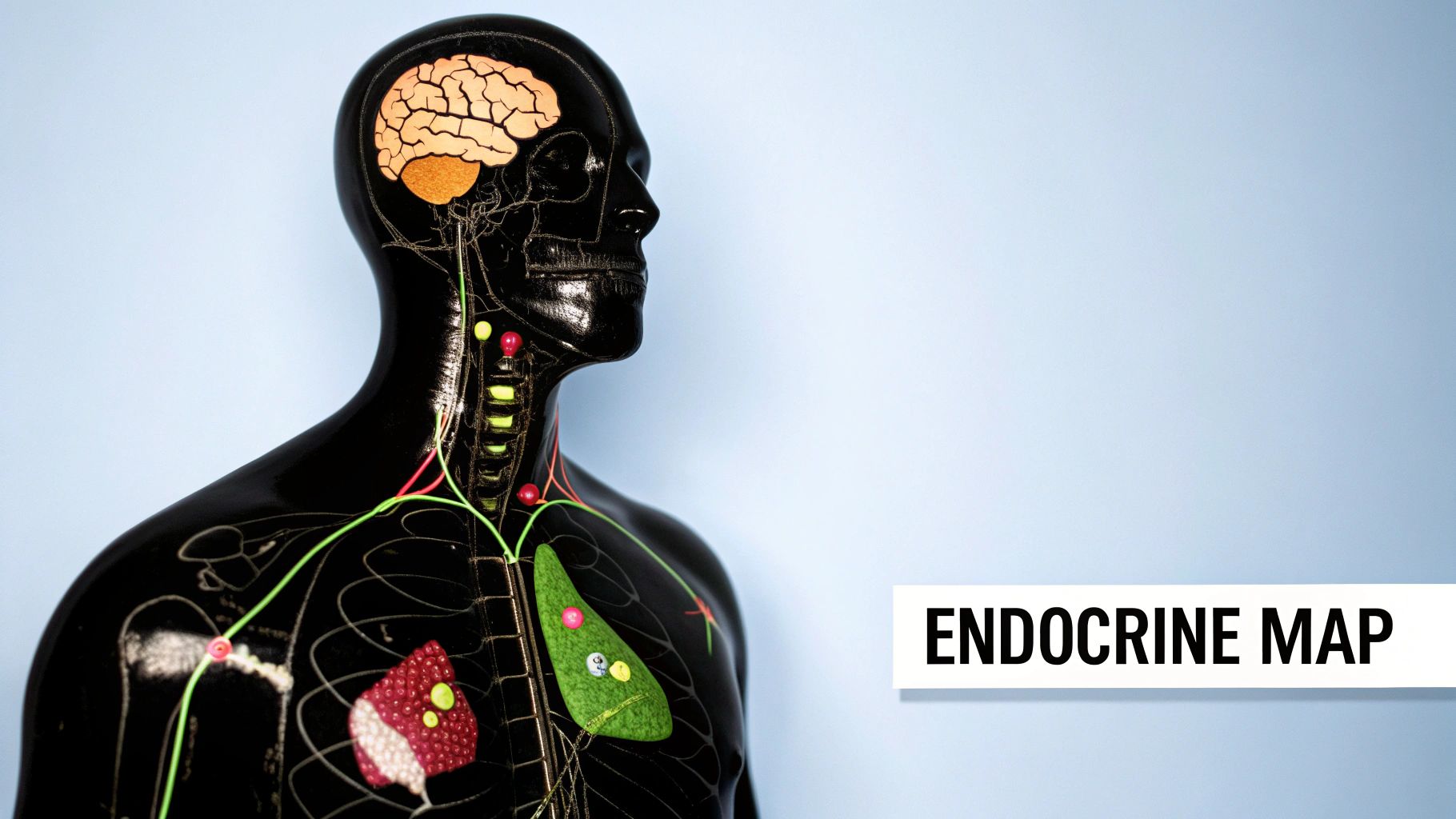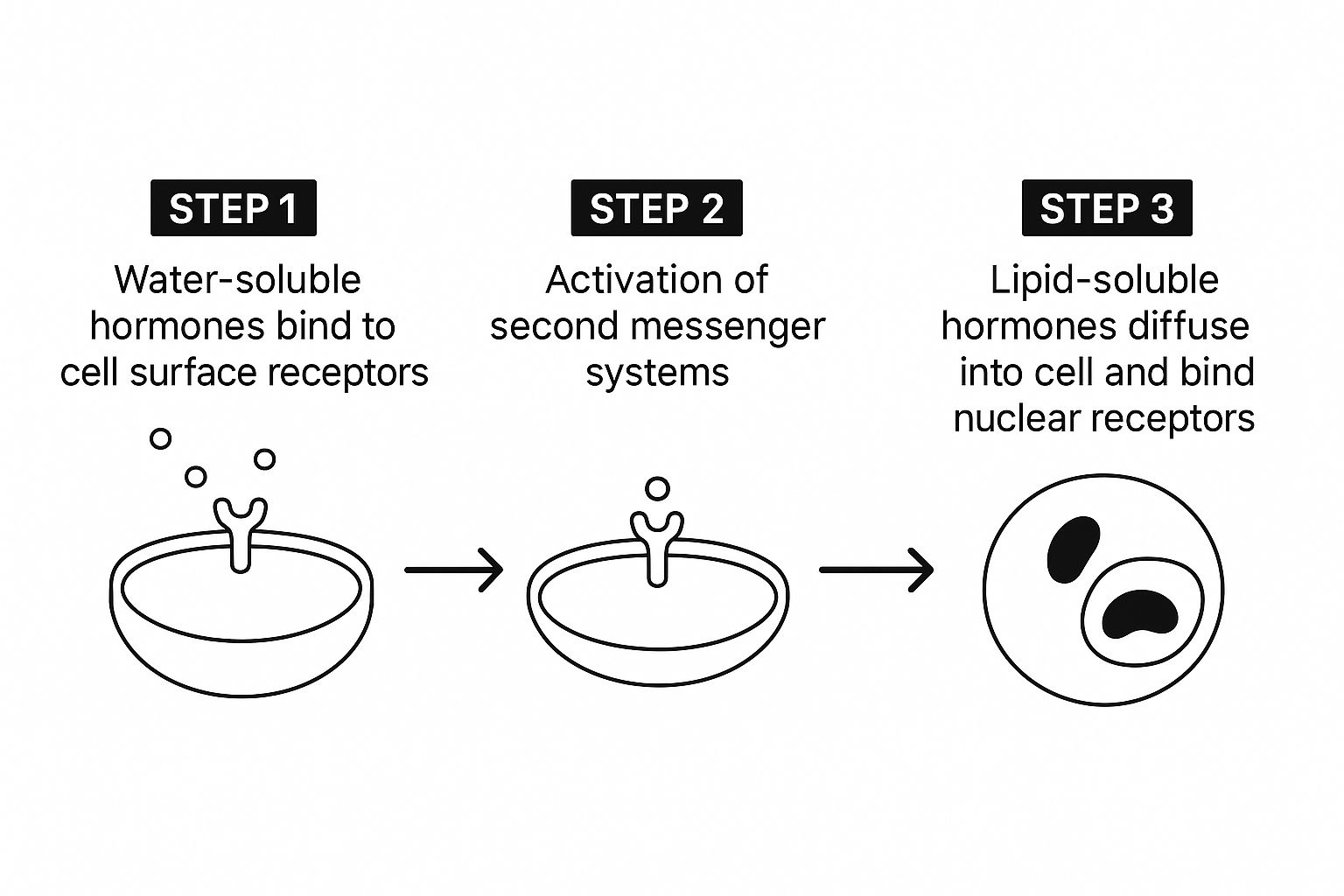Ready to master one of the body's most complex communication networks? This endocrine system study guide is your roadmap. We'll break down everything from the major glands to the hormones they produce and the intricate feedback loops that keep it all in balance.
Your Essential Map to the Endocrine System
Think of the endocrine system as the body's internal wireless network. Instead of sending emails or text messages, it uses chemical messengers called hormones to communicate. This system works quietly in the background, regulating everything from your metabolism and mood to growth and how you handle stress.

Unlike the nervous system, which fires off rapid-fire electrical signals for immediate responses, the endocrine system plays the long game. It releases hormones directly into your bloodstream, allowing them to travel throughout the body and deliver specific instructions to target cells. The effects are slower to start but are often more widespread and lasting.
The Major Players on the Board
To really get a handle on this system, you first need to meet its key players: the endocrine glands. Each gland has a highly specialized job, producing one or more unique hormones to carry out its mission.
Getting the terminology right is half the battle. If you're feeling rusty on the language, brushing up with our https://acemedboards.com/medical-terminology-study-guide/ can make a huge difference.
Here are the primary glands you absolutely need to know:
- Hypothalamus: The critical link between the brain and the endocrine system. It’s the ultimate control center for the pituitary gland.
- Pituitary Gland: Often called the "master gland" for a good reason—it directs the activity of many other endocrine glands.
- Thyroid Gland: This gland is all about energy. It manages your metabolism and body temperature.
- Adrenal Glands: Sitting right on top of your kidneys, these glands are your stress-response managers, also handling blood pressure and salt balance.
- Pancreas: This organ wears two hats, but its endocrine role is to regulate blood sugar levels using insulin and glucagon.
- Gonads (Ovaries and Testes): These are responsible for producing the hormones that drive reproduction.
Building Your Foundational Knowledge
This first look gives you the "what" and "where" of the endocrine system. The key to success is building on this foundation one step at a time. It's a progressive process. For those curious about the best ways to structure learning, some great resources on creating engaging and educational training materials explain how to build knowledge for better retention.
Key Takeaway: The endocrine system is a network of glands that secrete hormones to maintain homeostasis—the body's internal balance. Knowing each gland's location and its main job is the first step to mastering this topic for your exams.
To give you a quick reference tool, here's a simple table summarizing the key players we've just met.
Quick Overview of Major Endocrine Glands
| Gland | Location | Primary Hormone(s) | Main Function |
|---|---|---|---|
| Hypothalamus | Brain | Releasing & inhibiting hormones | Controls pituitary gland |
| Pituitary Gland | Brain | GH, TSH, ACTH, FSH, LH | Regulates other glands |
| Thyroid Gland | Neck | Thyroxine (T4), T3 | Metabolism & energy regulation |
| Adrenal Glands | On kidneys | Cortisol, Aldosterone, Adrenaline | Stress response, salt balance |
| Pancreas | Abdomen | Insulin, Glucagon | Blood sugar control |
| Gonads | Pelvic region | Estrogen, Progesterone, Testosterone | Reproduction & sexual traits |
Use this table as a starting point. In the sections that follow, we'll dive deeper into what these hormones actually do, how they talk to cells, and the elegant feedback systems that keep everything running smoothly. This map will guide you from basic anatomy all the way to complex physiology.
Exploring the Major Glands and Their Hormones
Alright, now that we have the lay of the land, let's take a tour of the endocrine system's major landmarks. This isn't just about memorizing names; it's about understanding the command centers that keep your body in balance.
Think of this as the "who's who" for your study guide, where we'll meet each key player and learn about the powerful hormones they send out into the bloodstream.

We're going to break down how these glands orchestrate everything, from your heart-pounding response to a sudden scare to how your body uses the energy from lunch. Getting this gland-by-gland breakdown right is absolutely essential for building a strong physiological foundation for your exams.
The Hypothalamus and Pituitary Gland: The Master Controllers
Sitting at the very top of the endocrine chain of command is the hypothalamus. It's a small but incredibly powerful region of the brain that acts as the bridge between your nervous system and your endocrine system. It's constantly monitoring your body's internal state, and when it senses something is off, it sends orders to its direct report: the pituitary gland.
Often called the "master gland," the pituitary is only about the size of a pea, but its influence is massive. It’s split into two distinct parts, the anterior and posterior lobes, each with its own job.
- Anterior Pituitary: This is the factory floor. It produces and releases hormones that tell other glands what to do. Think of Thyroid-Stimulating Hormone (TSH) and Adrenocorticotropic Hormone (ACTH), which are basically memos telling the thyroid and adrenal glands to get to work.
- Posterior Pituitary: This side is more of a storage warehouse. It doesn’t actually make its own hormones but instead stores and releases two critical ones made by the hypothalamus: oxytocin and antidiuretic hormone (ADH).
This intricate relationship creates a powerful command-and-control axis that governs a huge portion of your body's hormonal activity. Understanding this connection is non-negotiable.
The Thyroid and Parathyroid Glands: Metabolism and Mineral Managers
Tucked into your neck is the butterfly-shaped thyroid gland, your body’s chief metabolic regulator. It pumps out two main hormones, thyroxine (T4) and triiodothyronine (T3), which set the pace for how fast your cells burn energy.
When this gland is out of whack, you'll definitely notice. Too much thyroid hormone (hyperthyroidism) can crank up your metabolism, causing weight loss and anxiety. Too little (hypothyroidism) can make you feel sluggish, tired, and lead to weight gain.
Hiding behind the thyroid are four tiny parathyroid glands. They have one, highly specific job: regulating calcium levels in your blood by releasing parathyroid hormone (PTH). This is mission-critical, since calcium is essential for everything from muscle contraction and nerve signals to keeping your bones strong. PTH works on the bones, kidneys, and gut to make sure calcium stays within a very tight, healthy range.
The Adrenal Glands: The Stress Responders
Perched like little hats on top of your kidneys, the adrenal glands are your body's first responders in a crisis. Each gland is actually two glands in one: an outer cortex and an inner medulla, and they do very different things.
The adrenal cortex produces steroid hormones that you literally can't live without.
- Cortisol: Known as the "stress hormone," it helps manage metabolism, puts a lid on inflammation, and orchestrates your body's response to stress.
- Aldosterone: This hormone is all about maintaining blood pressure by carefully managing the salt and water balance in your body.
The adrenal medulla, on the other hand, is responsible for the famous "fight-or-flight" response. It churns out epinephrine (adrenaline) and norepinephrine, the hormones that give you that sudden surge of energy, make your heart pound, and sharpen your senses when danger strikes.
Key Insight: The study of these chemical messengers has a long and fascinating past. Early concepts of endocrinology can be traced back to ancient times when victorious warriors would consume the organs of their enemies, believing it would grant them strength or courage. The modern field, however, truly began with the discovery of adrenaline in 1893, proving that glands could release substances with systemic effects. The term 'hormone' itself wasn't even coined until 1905, marking the start of a century of breakthroughs. You can discover more insights about the history of endocrinology on news-medical.net.
The Pancreas: The Sugar Regulator
The pancreas wears two hats, but its endocrine role is all about managing blood sugar. It contains special cell clusters called the islets of Langerhans, which produce a pair of hormones with opposing actions.
- Insulin: Released when your blood sugar spikes (like after a meal), insulin is the key that unlocks your cells, letting glucose in to be used for energy.
- Glucagon: When your blood sugar drops too low, glucagon sends a signal to the liver, telling it to release its stored glucose back into the bloodstream.
This delicate balancing act is exactly what goes haywire in diabetes, the most common endocrine disorder in the United States, affecting over 10% of the population. In Type 1 diabetes, the body fails to produce insulin, while in Type 2, the body can't use insulin effectively.
The Gonads: The Reproductive Glands
Finally, we have the gonads—the ovaries in females and the testes in males. These are the primary factories for sex hormones, which are in charge of sexual development, reproduction, and all the secondary sexual characteristics that appear during puberty.
The ovaries produce estrogen and progesterone, the two hormones that direct the menstrual cycle and are essential for supporting a pregnancy. In males, the testes produce testosterone, which is crucial for sperm production and the development of male characteristics.
How Hormones Deliver Their Messages
Hormones are the body's long-distance messengers, but how do they actually deliver their instructions? Think of it this way: their messages aren't a city-wide announcement blasted over a loudspeaker. Instead, they're more like private letters intended for very specific recipients.
This targeted communication is all thanks to a beautifully simple system often compared to a lock and key.
Each hormone (the key) is uniquely shaped to fit into a specific receptor (the lock) located either on the surface or deep inside a target cell. A cell will only respond to a hormone if it possesses the correct receptor. This is how insulin, for example, travels throughout the entire body but only instructs muscle and fat cells to take up glucose, leaving other cells unaffected.
This fundamental mechanism is what gives the endocrine system its incredible precision. It's how hormones released from the brain can act solely on the adrenal glands, or how a single hormone from the pancreas can meticulously manage blood sugar levels across the body.
Water-Soluble vs. Lipid-Soluble Hormones
Not all hormonal "keys" work in the same way. The biggest difference comes down to their chemical makeup, which determines whether they can get past the cell's bouncer—the fatty cell membrane.
Based on this property, hormones fall into two main camps:
Water-Soluble Hormones: These hormones, like insulin and epinephrine, are built from amino acids. Because they can't pass through the fatty cell membrane on their own, they act like someone ringing a doorbell—they bind to receptors on the cell's outer surface to deliver their message.
Lipid-Soluble Hormones: This group includes steroid hormones (like testosterone and cortisol) and thyroid hormones. Being fat-soluble, they can slip right through the cell membrane, almost like having a key to the front door.
This chemical difference dictates not just how they travel through the bloodstream, but also the entire process of how they deliver their message once they arrive at their destination.
Let's break down the key differences in a simple table.
| Characteristic | Water-Soluble Hormones (e.g., Insulin, Epinephrine) | Lipid-Soluble Hormones (e.g., Steroids, Thyroid Hormone) |
|---|---|---|
| Transport in Blood | Dissolve freely in blood plasma. | Bound to transport proteins. |
| Receptor Location | On the cell surface (plasma membrane). | Inside the cell (cytoplasm or nucleus). |
| Mechanism of Action | Activates "second messengers" inside the cell. | Directly binds to DNA to alter gene expression. |
| Speed of Response | Fast and rapid (seconds to minutes). | Slower but longer-lasting (hours to days). |
As you can see, the path each hormone takes is fundamentally different, leading to distinct cellular outcomes.
The infographic below provides a great visual breakdown of these two distinct pathways.

This visual really clarifies things. Water-soluble hormones trigger a chain reaction inside the cell using those "second messengers," while lipid-soluble hormones march straight to the cell's command center—the nucleus—to directly influence its DNA.
The Mechanism of Action Deep Dive
Let's unpack those two pathways a bit more. When a water-soluble hormone binds to its surface receptor, it kicks off a cascade of internal signals. This "second messenger" system amplifies the original message, creating a rapid and powerful response, like activating or deactivating an enzyme almost instantly.
Lipid-soluble hormones, on the other hand, take a more direct route. After slipping into the cell, they bind to receptors floating in the cytoplasm or waiting in the nucleus. This newly formed hormone-receptor complex then acts as a transcription factor, binding directly to DNA to turn specific genes on or off. This process is slower but leads to much more profound and long-lasting changes in what the cell does.
Expert Insight: Understanding these mechanisms isn't just academic—it's the bedrock of pharmacology. Many modern drugs are designed to either mimic hormones (agonists) or block their receptors (antagonists), allowing us to manipulate these pathways to treat disease.
The evolutionary roots of this system are mind-bogglingly deep. The chemical precursors to steroid hormones, for instance, were present in prokaryotic organisms over 4,000 million years ago. In humans, the endocrine system develops from all three embryonic germ layers, with glands like the gonads starting to form by just the fifth week of gestation. You can read more about endocrine evolution on endocrinology.org.
Mastering these concepts of hormone action is a cornerstone of any endocrinology study plan. The complexity can be challenging, which is why focusing on ways to improve your memory retention through active recall and visualization is so effective. By breaking down these mechanisms into logical steps, you're building a solid framework for understanding both normal physiology and what goes wrong in disease states.
Understanding Feedback Loops and Hormone Control
The true genius of the endocrine system isn't just its ability to produce powerful hormones. It's in knowing exactly when to start and, more importantly, when to stop.
This incredible self-regulation is managed by elegant control systems called feedback loops. If you want to really understand the endocrine system for your exams, you absolutely have to grasp these mechanisms.
Think of the thermostat in your house. You set it to a comfortable 70°F. When the temperature drops, the heater kicks on. Once it hits 70°F, it shuts itself off to keep the house from getting too hot. This simple, self-correcting process is a perfect analogy for how most hormones are controlled.
Negative Feedback: The Body's Thermostat
The vast majority of hormone regulation runs on a negative feedback loop. This is the system’s primary method for maintaining homeostasis—that stable, balanced internal environment your body needs to function.
The principle is simple: the final product of a pathway turns around and shuts down the very process that created it.
Let's look at the thyroid gland to see this in action. The hypothalamus releases Thyrotropin-Releasing Hormone (TRH), which signals the pituitary to release Thyroid-Stimulating Hormone (TSH). TSH then travels to the thyroid, telling it to produce its hormones (T3 and T4).
Here’s where the "feedback" kicks in:
- Stimulus: The hypothalamus detects low levels of thyroid hormone in the blood.
- Response: The hypothalamus and pituitary release TRH and TSH to get the thyroid working.
- Correction: The thyroid pumps out T3 and T4, raising their levels in the blood and boosting metabolism.
- Inhibition: As T3 and T4 levels rise, they travel back to the hypothalamus and pituitary and tell them to stop releasing TRH and TSH.
This "shut-off" signal prevents the body from making too much thyroid hormone, which would lead to a dangerous state like hyperthyroidism. The system is constantly monitoring and adjusting, keeping hormone levels within a very narrow, healthy range. It’s a beautifully efficient cycle of control.
Key Takeaway: In a negative feedback loop, the output of a system acts to shut down the initial stimulus. It’s the body's way of saying, "Okay, we've got enough, you can stop now."
This same principle applies all over the endocrine system, from cortisol regulation by the adrenal glands to testosterone production in the testes. Understanding this concept is fundamental to diagnosing endocrine disorders, which often happen when these feedback mechanisms break down.
Positive Feedback: Amplifying a Process to Completion
While far less common, positive feedback loops are just as critical for certain goal-oriented processes. Instead of shutting down a signal, positive feedback amplifies it, pushing a process forward until a specific event is finished.
Forget the thermostat. Think of a snowball rolling down a hill—it just gets bigger and faster until it reaches the bottom.
The classic example of this is oxytocin's role in childbirth.
- The process starts when the baby's head presses against the cervix, stretching it.
- This stretching sends nerve impulses from the cervix to the brain.
- The brain tells the pituitary gland to release oxytocin.
- Oxytocin travels to the uterus and causes stronger contractions.
- These stronger contractions push the baby's head even harder against the cervix, causing more stretching.
- This increased stretching sends more signals to the brain, which releases even more oxytocin.
This escalating cycle continues, with each contraction getting more powerful than the last, until the ultimate goal—the birth of the baby—is achieved. Once the baby is delivered, the stretching stimulus is gone, and the positive feedback loop is broken.
To really nail your endocrinology section, you need to master how both of these feedback loops work. They are the core of hormone control.
Common Endocrine Disorders Explained
Understanding the elegant design of the endocrine system is one thing. Seeing what happens when it all goes wrong is another entirely. This is where the textbook knowledge hits the clinic floor. Endocrine disorders pop up when a gland produces too much (hyper-secretion) or too little (hypo-secretion) of a hormone, throwing the body's delicate chemical balance into chaos.

Diving into these conditions is actually a fantastic study strategy. When you can connect a patient's symptoms directly back to what a specific hormone is supposed to do, your grasp of physiology becomes rock-solid. You start to see the real-world impact of these chemical imbalances.
Thyroid Disorders: Hyperactivity and Sluggishness
Think of the thyroid gland as the body's metabolic thermostat. When it goes haywire, the effects ripple through every single system, often in dramatic ways.
Hyperthyroidism: This is the body in overdrive. Too much T3 and T4 cranks the metabolic engine to the max. Patients feel anxious, lose weight despite a ravenous appetite, and complain of a racing heart or tremors. A common culprit here is Graves' disease, an autoimmune condition.
Hypothyroidism: On the flip side, a shortage of thyroid hormone slams the brakes on everything. Patients feel exhausted, gain weight, are always cold, and notice dry skin and hair loss. It’s like the body's engine is sputtering and running at half speed.
If you remember that T3 and T4 set the metabolic rate, you can logically deduce the symptoms of having too much or too little. Making that connection is a huge step toward mastering this for your exams.
Diabetes Mellitus: A Problem of Sugar Control
Diabetes is easily the most famous endocrine disorder—and the most common in the United States, affecting over 10% of the population. At its heart, diabetes is a breakdown in how the body uses insulin to manage blood sugar (glucose).
The pancreas is ground zero, and the specific type of failure determines the diagnosis:
Type 1 Diabetes: This is an autoimmune attack. The body’s own immune system mistakenly destroys the insulin-producing beta cells in the pancreas, leading to a complete lack of insulin. Without insulin to act as a "key," glucose can't get into the cells and stays trapped in the blood, causing hyperglycemia (high blood sugar).
Type 2 Diabetes: This form is all about insulin resistance. The body's cells become less responsive to insulin's signal, almost like the locks on the cell doors are rusty and the key won't turn. The pancreas works overtime, pumping out more and more insulin to compensate, until it eventually gets exhausted and can't keep up.
Key Insight: While both types result in high blood sugar, their root causes are completely different. Type 1 is a production problem (no insulin), while Type 2 is a reception problem (cells ignore insulin).
Grasping this fundamental difference is crucial for answering clinical questions on your boards. It explains why someone with Type 1 absolutely needs lifelong insulin therapy, while someone with Type 2 might start with lifestyle changes and oral meds.
Adrenal Gland Disorders: The Extremes of Cortisol
The adrenal glands, specifically the cortex, produce cortisol—the body's main stress hormone. When cortisol levels are out of whack, the effects on metabolism, inflammation, and blood pressure are profound.
Cushing's Syndrome: This is what happens when you have way too much cortisol. The classic signs are impossible to miss: weight gain (especially a "moon face" and around the abdomen), easy bruising, weak muscles, and mood swings. This can be caused by a tumor on the adrenal or pituitary gland, or even long-term use of steroid medications.
Addison's Disease: This is the exact opposite—a severe deficiency of cortisol (and often aldosterone). The initial symptoms can be vague, like fatigue and weakness, but they progress to low blood pressure and a very characteristic skin darkening. It’s a serious condition that requires lifelong hormone replacement.
These two disorders perfectly illustrate how a single hormone, when imbalanced, can create a cascade of distinct symptoms throughout the body.
The field of endocrinology has made incredible leaps in treating these conditions. This progress is built on a rich history, from purifying hormones in the 1920s and discovering steroids in the 1930s, to developing synthetic hormones in the mid-20th century. Today, the focus is shifting to genetics and integrating physiology with pathophysiology for more targeted treatments. You can learn more about the evolution of endocrine treatments on NCBI.
Studying these common disorders provides a practical framework for your endocrine system study guide. By connecting the dots between a hormone's job and the symptoms of its imbalance, you'll move beyond rote memorization to a deep, clinical understanding that will stick with you.
Frequently Asked Questions About the Endocrine System
As you dive deep into your endocrinology study guide, some questions inevitably surface. These are the tricky concepts, the ones that love to trip students up on exam day. This section is all about tackling those common hurdles head-on, giving you clear, straightforward answers to cement your understanding.
Think of this as a final check-in before the big test. We'll clear up any lingering confusion, draw sharp lines between similar-sounding systems, and make sure you’ve got a rock-solid grip on the most critical concepts.
What Is the Difference Between the Endocrine and Nervous Systems?
This is one of the first big questions you need to nail down. Both the endocrine and nervous systems are massive communication networks, but they work on completely different timelines. It’s like the difference between sending a lightning-fast text message versus sending a letter through the mail.
The Nervous System is Fast: It uses electrical signals (action potentials) and chemical messengers (neurotransmitters) to send immediate, highly specific messages. Think about snatching your hand away from a hot stove—that split-second reaction is your nervous system at work.
The Endocrine System is Slow and Broad: It uses chemical hormones released directly into the bloodstream. These messages travel much more slowly and can have widespread, long-lasting effects on multiple organs all at once. Think about processes like growth or metabolism—those are classic, long-haul jobs for the endocrine system.
Simply put, the nervous system is for rapid, short-term control, while the endocrine system manages slower, long-term processes.
Which Gland Is the True Master Gland?
For years, the pituitary gland got all the credit. It was called the "master gland" because it releases hormones that control so many other endocrine glands, like the thyroid and adrenals. And while its influence is huge, that title is a bit of a misnomer.
The real conductor of the endocrine orchestra is the hypothalamus. This small but mighty region of the brain is the critical link between your nervous system and your endocrine system. It’s constantly monitoring your body's internal environment and giving the pituitary its marching orders, telling it what to release and when to release it.
Key Takeaway: The pituitary gland might be the manager, but the hypothalamus is the CEO. It holds the ultimate authority, making it the true "master" of the endocrine system.
What Exactly Is a Hormone Cascade?
A hormone cascade, sometimes called a signaling axis, is a beautiful chain reaction where one hormone triggers the release of a second, which then triggers the release of a third. It’s like a series of dominoes falling, creating a precise and amplified response.
The best-known example is the Hypothalamic-Pituitary-Adrenal (HPA) axis:
- First Domino: Under stress, the hypothalamus releases Corticotropin-Releasing Hormone (CRH).
- Second Domino: CRH travels to the pituitary gland, signaling it to release Adrenocorticotropic Hormone (ACTH).
- Third Domino: ACTH travels through the blood to the adrenal glands, telling them to pump out cortisol.
This cascade system is brilliant because it allows for multiple points of regulation—especially through negative feedback loops, where the final hormone (cortisol) can circle back to shut down the initial signals from the hypothalamus and pituitary.
How Can I Effectively Study and Memorize the Hormones?
Trying to memorize dozens of hormones, where they come from, and what they do can feel like an impossible task. The secret isn't just brute-force memorization; it's about moving to active learning techniques that build real, lasting connections in your brain.
This is where methods like visualization and active recall completely change the game. Instead of just rereading your notes over and over, you need to be actively testing yourself.
One of the most powerful ways to do this is with flashcards or practice questions. For a full breakdown of this high-impact study method, check out our guide on applying active recall for medical students. This forces your brain to actually retrieve the information, which strengthens the neural pathways far more than passive reading ever could.
To really test your knowledge, you might also find it useful to learn about crafting effective online multiple-choice tests, which can help you create your own practice quizzes.
Why Are Feedback Loops So Important to Understand?
Feedback loops are the absolute core of endocrine regulation. They're the control systems that keep everything in balance and prevent the whole system from going haywire. Without them, your body would have no way to manage hormone levels, leading to dangerous and chaotic imbalances.
Negative Feedback: This is the most common type and works just like a thermostat. When a hormone level rises high enough, it sends a signal to shut off its own production line. This is what maintains homeostasis and keeps things stable.
Positive Feedback: This is much rarer and works to amplify a process until a specific endpoint is reached. A classic example is oxytocin during childbirth—its release causes contractions, which cause more oxytocin to be released, and so on, until the baby is delivered.
Understanding feedback loops isn't just an academic exercise. Nearly every endocrine disorder you'll encounter, from thyroid disease to Cushing's syndrome, is rooted in a broken feedback mechanism. Grasping this concept is fundamental to diagnosing and truly understanding pathophysiology.
Feeling ready to conquer your exams? At Ace Med Boards, we specialize in providing the expert guidance and personalized strategies you need to excel. Our one-on-one tutoring for USMLE, COMLEX, and Shelf exams is designed to turn your hard work into top scores. Book a free consultation today and let's build your path to success together.
